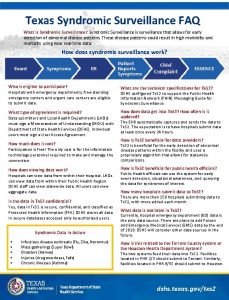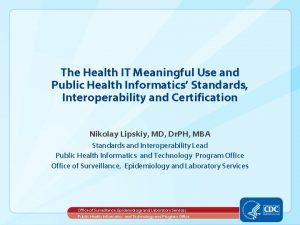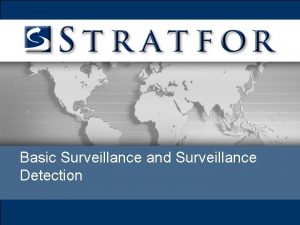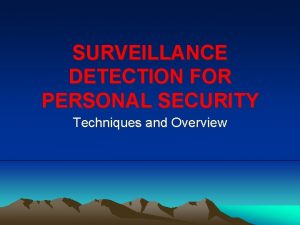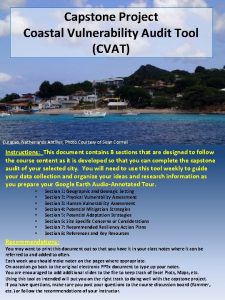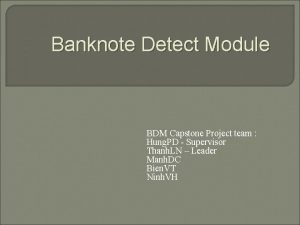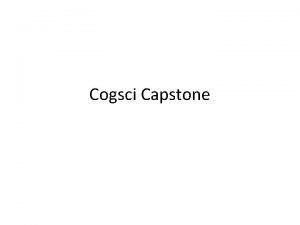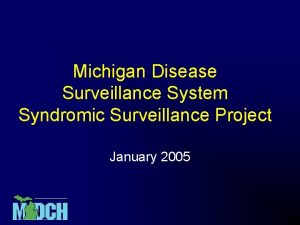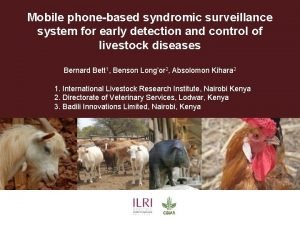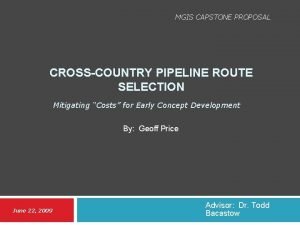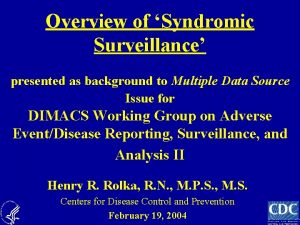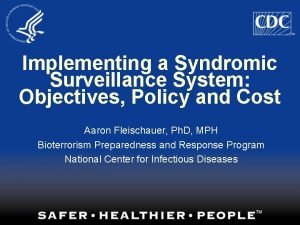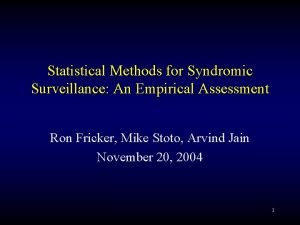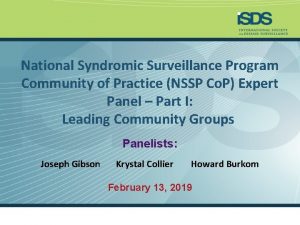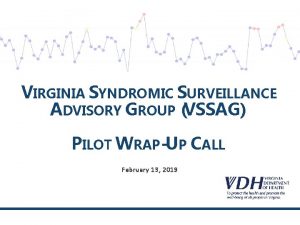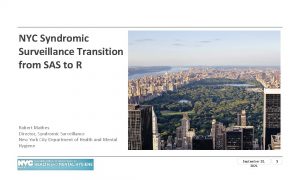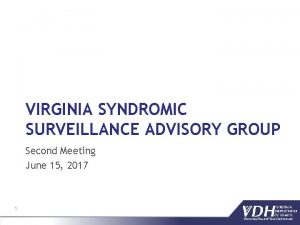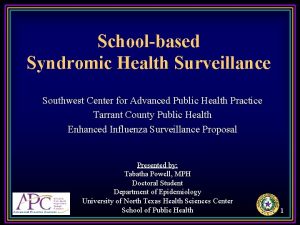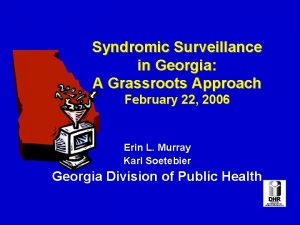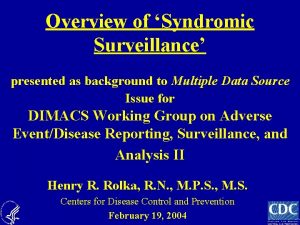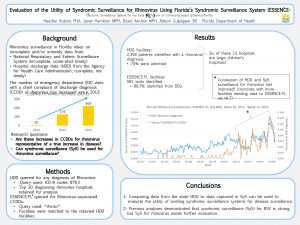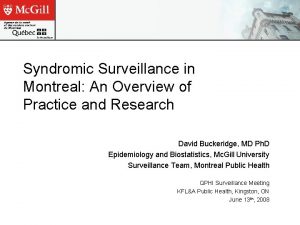Cluster Detection Comparison in Syndromic Surveillance MGIS Capstone






















- Slides: 22

Cluster Detection Comparison in Syndromic Surveillance MGIS Capstone Project Proposal Tuesday, July 8 th, 2008

Background

Syndromic Surveillance • Syndromic Surveillance is the application of health -related data to identify signals of potential events or outbreaks before they would otherwise be detected through standard means. • A key method of syndromic surveillance involves the detection of statistically significant spatial signals using Sa. TScan. • In NYC, data is analyzed daily from Emergency Department (ED) visits. The date and time of visit, age, sex, home ZIP Code and free-text chief complaint of each patient is recorded.

Goals and Objectives

Goals and Objectives • While syndromic surveillance has been around for a number of years, there are geographic considerations that may influence the accuracy of the spatial analysis being performed by Sa. TScan. • One program being evaluated, Fle. XScan, may provide for fewer false signals in our system, and provide a more accurate picture of a cluster. • Combining such programs with additional geographic information analysis may provide the most accurate spatial assessment of clusters.

Characterizing Geography of Input Files Input files to both Sa. TScan and Fle. XScan are important to construct accurate analysis. This project considers how important those considerations actually are: 1. If centroids reflect characteristics of an underlying population, they should not be arbitrary. 2. How do differences in coordinate / measurement systems affect accuracy? 3. How do natural / man-made boundaries impact adjacency?

Detecting Spatial Clusters: Sa. TScan • NYC presently uses Sa. TScan to detect spatial clusters in space and time. • Sa. TScan is good at picking out clusters that are circular in nature. • A known limitation is that many clusters are not circular in nature.

Detecting Spatial Clusters: Fle. XScan • Fle. XScan employs a flexible scan statistic using a matrix design. • The matrix identifies neighboring areas, and may better detect non-circular clusters.

Methodology

How do geographic considerations impact final results? Sa. TScan and Fle. XScan will be evaluated using preferable characteristics of software packages that perform spatial exploratory analysis (Anselin, 2004): 1. Effective data input 2. Handling of distance and spatial weighting 3. Provides descriptive statistics 4. Performs point pattern analysis 5. Spatial autocorrelation analysis (LISA) 6. Modeling spatial variation in events and linking to explanatory variables 7. Mapping and visualization of results

How effective is each program at detecting syndromic signals? Fle. XScan and Sa. TScan output will be compared using the following criteria*: 1. Most likely cluster (primary cluster) identified 2. Secondary clusters identified 3. Location and radius or area of identified cluster 4. P-value, log-likelihood ratio 5. Recurrence interval * Takahashi et al’s “A flexibly shaped space-time scan statistic for disease detection and monitoring”, April 2008, can be used as a guide for correctly comparing Sa. TScan with Fle. XScan.

Proposed Framework • Purely Spatial Analysis completed using Sa. TScan and Fle. XScan against ED daily intake data • Results compared / analyzed • Fine-tuning of input files using geographic considerations (centroid weighting, natural boundaries, true adjacency) • Space-Time Analysis applied (as time allows)

Data: Emergency Department (ED) Daily Intake Data • Project will initially investigate six key datasets:

Detecting Spatial Clusters: Fle. XScan Original Sa. TScan Cluster Fle. XScan Cluster

How do natural / man-made boundaries impact adjacency? • Syndromic Data

Assigning Connectivity: Matrix File • Geo. Da used to create a matrix file. • Connectivity becomes an issue, as it is defined across boundaries and distance.

Adjacency, Natural and Man-Made Boundaries • Comparing cluster detection accuracy across boundaries.

ZIP Code Centroid Weighting

Coordinate Systems • Compare cluster detection behaviors between a set of geographic (unprojected) coordinates and a set of projected coordinates. • If measurements vary and thereby change results of analysis, the input coordinate system weighs significantly on the output of the program. Di. Biase, David (1999 -2006) The Nature of Geographic Data, Lesson 2: Scales and Transformations. The Pennsylvania State University World Campus Certificate Program in GIS. Accessed May 2006.

Proposed Timeline

Proposed Timeline To date: • 09 / 07 – GEOG 586 Quarter Project, “Improving Syndromic Surveillance Signal Detection Using GIA” • 12 / 07 – Application to NSF / EAPSI Program, “Cluster Detection Comparison in Syndromic Surveillance: Fle. XScan and Sa. TScan” • 02 / 08 – Notice of NSF Award • 06 / 08 – GEOG 596 A Capstone Proposal, Work begins at NIPH – Wako-shi, Saitama, Japan Planned: • 08 / 08 – NSF research period ends • 12 / 08 - Seventh Annual International Society for Disease Surveillance Conference, Raleigh, NC

Thank you… Chris Goranson, GISP Director GIS Center Bureau of Epi Services 125 Worth Street, Room 315, CN-6 New York, NY 10013 212 -788 -4334 cgoranso@health. nyc. gov
 Texas syndromic surveillance
Texas syndromic surveillance Syndromic surveillance
Syndromic surveillance Surveillance detection route
Surveillance detection route Surveillance detection route
Surveillance detection route Hostile surveillance techniques
Hostile surveillance techniques Penn state mgis
Penn state mgis Mgis 317 study guide
Mgis 317 study guide Comparison test
Comparison test Culinary capstone project
Culinary capstone project Capstone logiciel
Capstone logiciel Renee lawson hardy today
Renee lawson hardy today Capstone tracking
Capstone tracking Career life connections capstone project examples
Career life connections capstone project examples Vulnerability capstone
Vulnerability capstone Bdm capstone project
Bdm capstone project Capstone video games
Capstone video games Experience in culminating activity
Experience in culminating activity Richard quinn cheating
Richard quinn cheating Capstone approach
Capstone approach Capstone meeting
Capstone meeting Enrollment system capstone
Enrollment system capstone Vulnerability capstone
Vulnerability capstone Pasco capstone software
Pasco capstone software
